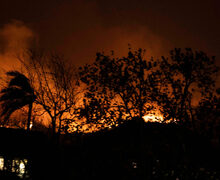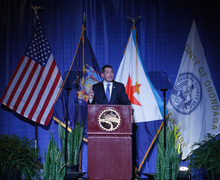Goldberg: New York City schools adopt new holidays, others should follow
New York City Mayor Bill de Blasio announced earlier this month that two Muslim feast days, Eid al-Adha and Eid al-Fitr, would be added permanently to the New York City public school calendar as days off. With this decision, New York City becomes one of the first, and without a doubt the largest American public school system, to recognize these holidays.
Following New York’s example, American public school systems should respect the beliefs of their students and recognize significant religious holidays.
This decision, promised by de Blasio during his campaign in 2013, should be commended. Muslim students make up a significant portion of New York City public school students — a Columbia University study pegs it at upwards of 10 percent and growing citywide. Providing for the religious and cultural needs of an important contingent of students and their families will go a long way in fostering understanding and respect for a community that has been under quite a bit of fire lately.
In the wake of this announcement, New York City has seen a renewed push from other religious and cultural groups to have additional holidays recognized. Most prominent is Lunar New Year, which is celebrated by a spectrum of Asian Americans and was also promised as a school holiday by de Blasio in his campaign. Additionally many New Yorkers have been advocating for the inclusion of Diwali, the Hindu Festival of lights, as a day off.
With Asian Americans comprising almost 15 percent of the student population in New York City, and Indian and South Asian Americans comprising a similarly large portion, de Blasio and the New York City School District should seriously push to include these holidays on the calendar.
The logic behind giving these days off has more secular grounds as well. The idea of giving any day off stems from the ability of schools to function normally. When too large a percentage of students and faculty may be absent, normal function is not possible, which is the case on many of these days. For example, in major centers of the Muslim population, where these students might make up 40 percent or more of a school’s enrollment, schools certainly cannot function properly on these holidays.
As the largest and most prominent school district in the nation, New York City should continue to embrace diversity and set the standard for other districts across America, which should follow suit as quickly as possible.
In districts where certain populations are not large — say, a small Muslim community of about 1 percent of the population — it, of course, would cause damage to the learning environment with less benefit for the students to give these days off. In these cases, communities should not be released of the charge to respect and celebrate the diversity of their students. Instead, they should create alternative policies like those already found in many municipalities — noting these holidays on the calendar, and arranging for excused absences for observant students.
There is certainly no one-size-fits-all solution for facilitating students in their religious and cultural observances; neither in the case of deciding which holidays to recognize, nor in the case of individual districts’ decisions to do so. What is important is that our school systems continue to allow for students and their families to follow their beliefs and observe as they see fit.
Zach Goldberg is a senior economics, policy studies and energy and its impacts major. His column appears weekly. He can be reached at zrgoldbe@syr.edu and followed on Twitter @zgolds.
Published on March 18, 2015 at 11:57 pm





